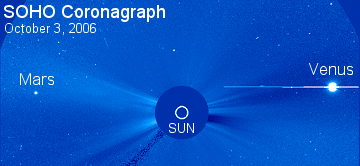 Autumn is here, and it's a wonderful time for stargazing. Find out what's up from Spaceweather PHONE.
Autumn is here, and it's a wonderful time for stargazing. Find out what's up from Spaceweather PHONE.
COMET C/2006 T1 (LEVY): Proving that fancy CCD cameras are not required to discover comets, David H. Levy of Tucson, AZ, reports his visual discovery with a 0.41-m reflector of a diffuse comet close to Saturn in the sky: ephemeris. The new comet glows like a 10th magnitude star, making it an easy target for medium-to-large backyard telescopes. Ref: IAU Circular 8757.
CONVERGING PLANETS: Venus and Mars are converging on the sun. You can't see the event with the naked eye, but SOHO can. The spacecraft has a coronagraph onboard able to block the sun's glare and reveal nearby stars and planets:

As October unfolds, Mars will approach the sun from the left, Venus from the right, eventually forming a compact triangle less than one degree wide. Dates of closest approach: Oct. 23rd - 27th. Mark your calendar and join SOHO for a ring-side seat.
COMET SWAN: There's a new comet in the night sky, Comet Swan. At present, it is too dim for the naked eye, but "the comet is a spectacular sight through binoculars or a small telescope," reports Chris Schur of Payson, Arizona. In Leeds, UK, Tony Cook took this picture of Swan's sinuous tail:

Comet Swan on Sept. 30th, a 9x4 minute exposure.
Ready to see for yourself? Set your alarm before dawn; the comet rises just ahead of the morning sun. "Look behind the back leg of the Great Bear," advises Cook. "You should be able to make out a greenish fuzzball of 6th magnitude." Sky maps: Oct 3rd, 4th, 5th, 6th.
more images: from Chris Schur of Payson, Arizona (9/30); from Vincent Jacques of Breil, France (9/28).

